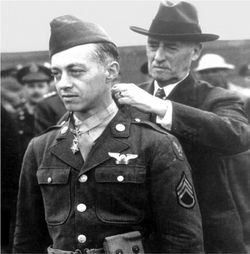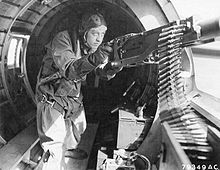- Maynard Harrison Smith
-
Staff Sergeant Maynard Harrison Smith United States Army Air Corps 
Sec.of War Henry L. Stimson awards MOH to S/Sgt. SmithNickname Snuffy Smith Born May 19, 1911
Caro, MichiganDied May 11, 1984 (aged 72) Allegiance  United States of America
United States of AmericaService/branch United States Army Air Corps Years of service 1942–1945 Rank Staff Sergeant Unit 423d Bombardment Squadron Battles/wars World War II Awards Medal of Honor
Air MedalMaynard Harrison Smith, aka Snuffy Smith, (May 19, 1911 - May 11, 1984), US Army Air Forces Staff Sergeant and gunner aboard a B-17 Flying Fortress bomber in World War II, received the Medal of Honor for his conduct during a bombing mission over Germany on May 1, 1943.[1][2]
Contents
Enlistment
Maynard H. Smith enlisted in the US Army Air Forces in 1942. After completing basic training he volunteered for aerial gunnery school. At the time all aerial gunners were non-commissioned officers and the move to the school was a quick way for the private to gain rank and pay.[2][3]
After completing the aerial gunnery school, he was shipped overseas to Thurleigh, Bedfordshire, in south-central England, where he joined the 423rd Bombardment Squadron, 306th Bomb Group. Staff Sergeant Smith quickly gained a reputation as a stubborn and obnoxious airman who did not get along well with the other airmen stationed there, hence his nickname "Snuffy Smith". Consequently it was six weeks before he was assigned his first combat mission.[2][3]
Medal of Honor action
It was during his first mission, on May 1, 1943 that Staff Sergeant Smith, who was assigned to the ball gun turret, helped save the lives of six of his wounded comrades, put out a blazing fire, and drove off wave after wave of German fighters.
The target of the mission was the U-Boat pens at Saint-Nazaire in Loire-Atlantique, France, on the Bay of Biscay. Saint Nazaire was heavily defended by antiaircraft guns and was nicknamed "flak city" by the airmen.[4]
Several of the bombers failed to rendezvous as intended, and others had mechanical problems and had to turn back. The middle portion of the bombing mission went well, with no German fighters engaging the mission until after they had released their bomb loads. The bombers managed to drop their payload on target with little resistance from the Germans in occupied France. As the fighters came up, the bombing group managed to elude them by flying into a large cloud bank.[4]
Due to a navigational error, after being in the cloud bank, the navigator in the lead plane believed he was approaching the southern coast of Britain. In fact, the aircraft were approaching the heavily fortified German-occupied city of Brest, France and the southern coast of the Breton Peninsula. The pilot began to descend to 2,000 feet and was almost immediately overtaken by several German fighters and thick anti-aircraft fire.[5]
Staff Sergeant Smith's bomber was hit, rupturing the fuel tanks and igniting a massive fire in the center of the fuselage. The damage to the aircraft was severe, knocking out communications and compromising the fuselage's integrity. Smith's ball turret lost power and he scrambled out to assist the other crew members. Three crew members bailed out, while Smith tended to two others who were seriously wounded.
In between helping his wounded comrades, Smith also manned the .50 caliber machine guns and fought the raging fire. The heat from the fire was so intense that it had begun to melt the metal in the fuselage, threatening to break the plane in half.
For nearly 90 minutes, Smith alternated between shooting at the attacking fighters, tending to his wounded crew members and fighting the fire. To starve the fire of fuel, he threw burning debris and exploding ammunition through the large holes that had been melted in the fuselage.
Staff Sergeant Smith's bomber reached England and landed at the first available airfield, where it broke in half as it touched down. Smith's bomber had been hit with over 3,500 bullets and shrapnel.
While the three crew members that bailed out were never recovered and presumed lost at sea, Smith's efforts on that day undoubtedly saved the lives of six others aboard his aircraft.[3]
Journalist Andy Rooney, at the time a reporter for Stars and Stripes, was at the base where Smith's plane landed and wrote a front page story about it. While reflecting on Smith's award years later on 60 Minutes, Rooney indicated "I was proud of my part in that."[6]
Smith was assigned to KP duty the week that he was awarded the Medal of Honor as punishment for arriving late to a briefing. Secretary of War Henry L. Stimson placed the Medal around Smith's neck during a formation.[7]
Medal of Honor citation
Citation text:[1]
For conspicuous gallantry and intrepidity in action above and beyond the call of duty. The aircraft of which Sgt. Smith was a gunner was subjected to intense enemy antiaircraft fire and determined fighter aircraft attacks while returning from a mission over enemy-occupied continental Europe on 1 May 1943. The aircraft was hit several times by antiaircraft fire and cannon shells of the fighter aircraft, 2 of the crew were seriously wounded, the aircraft's oxygen system shot out, and several vital control cables severed when intense fires were ignited simultaneously in the radio compartment and waist sections. The situation became so acute that 3 of the crew bailed out into the comparative safety of the sea. Sgt. Smith, then on his first combat mission, elected to fight the fire by himself, administered first aid to the wounded tail gunner, manned the waist guns, and fought the intense flames alternately. The escaping oxygen fanned the fire to such intense heat that the ammunition in the radio compartment began to explode, the radio, gun mount, and camera were melted, and the compartment completely gutted. Sgt. Smith threw the exploding ammunition overboard, fought the fire until all the firefighting aids were exhausted, manned the workable guns until the enemy fighters were driven away, further administered first aid to his wounded comrade, and then by wrapping himself in protecting cloth, completely extinguished the fire by hand. This soldier's gallantry in action, undaunted bravery, and loyalty to his aircraft and fellow crewmembers, without regard for his own personal safety, is an inspiration to the U.S. Armed Forces.
See also
References
 This article incorporates public domain material from websites or documents of the United States Army Center of Military History.
This article incorporates public domain material from websites or documents of the United States Army Center of Military History.
- ^ a b "Medal of Honor recipients". Medal of Honor citations. United States Army Center of Military History. August 3, 2009. http://www.history.army.mil/html/moh/wwII-m-s.html. Retrieved July 1, 2010.
- ^ a b c SSgt. Maynard H. Smith - Arlington National Cemetery
- ^ a b c Maynard H. Smith - Home of Heroes
- ^ a b Mikaelian, Allen, with Mike Wallace, (2002). - Medal of Honor: Profiles of America's Military Heroes from the Civil War to the Present. - New York: Hyperion. - pp.146-147. - ISBN 9780786866625.
- ^ Mikaelian. pp.147-148.
- ^ Rooney, Andy (March 6, 2009). "Andy On Heroism - Andy Rooney Explains Why Most Heroes Are Unlikely". CBS News. http://www.cbsnews.com/stories/2009/03/06/60minutes/rooney/main4848033.shtml. Retrieved 2009-03-09
- ^ Mikaelian. pp.137.
Categories:- Army Air Forces Medal of Honor recipients
- American military personnel of World War II
- 1911 births
- 1984 deaths
- United States Army Air Forces soldiers
Wikimedia Foundation. 2010.

